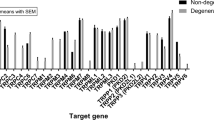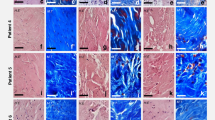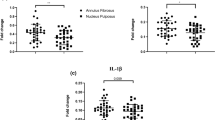Abstract
Transient receptor potential (TRP) channels are widely expressed cation channels that play an essential role in mediating Ca2+ homeostasis and are considered potential regulators of inflammatory pain. This study investigates the expression of the TRP channel subtypes TRPV1, TRPV4, TRPC6, TRPM2, TRPM8 in lumbar intervertebral disc (IVD) biopsies from patients with chronic low back pain (LBP). We determined the expression of these TRP channel subtypes in the annulus fibrosus (AF) and the nucleus pulposus (NP) from 46 patients with LBP undergoing 1–2 level lumbar fusion surgery for degenerative disc disease. The mRNA transcripts were analyzed using quantitative real-time polymerase chain reaction (RT-qPCR), and the expression levels were compared against visual analog scale (VAS) and oswestry disability index (ODI) scores (0–100) for pain and disability. A significant positive correlation was demonstrated between VAS score and the mRNA expression of TRPV1, TRPC6, TRPM2, TRPM8 in the AF. We also found a significant positive correlation between ODI scores and expression of TRPV1 and TRPM8. Further, there is a significant positive correlation between TNF-α and TRPV1, TRPM2 and TRPM8 expression in the AF, and IL-6 to TRPV1 in the NP. Interestingly, when investigating treatment response via a 12-month postoperative follow-up ODI, we found a significant correlation between only TRPV1 expression at baseline and the follow-up ODI scores, which indicates this marker could predict the effectiveness of surgery. These results strongly suggest an association between pain, inflammatory mediators, and TRP channel expression in lumbar disc biopsies of patients with chronic LBP.








Similar content being viewed by others
Data availability
The datasets generated and/or analysed during the current study are available from the corresponding author on reasonable request.
References
Maher C, Underwood M, Buchbinder R (2017) Non-specific low back pain. Lancet 389(10070):736–747
Leboeuf-Yde C et al (2009) Pain in the lumbar, thoracic or cervical regions: do age and gender matter? a population-based study of 34,902 Danish twins 20–71 years of age. BMC Musculoskelet Disord 10(1):39
Sadowska A et al (2019) Differential regulation of TRP channel gene and protein expression by intervertebral disc degeneration and back pain. Sci Rep 9(1):18889
Raj PP (2008) Intervertebral disc: anatomy-physiology-pathophysiology-treatment. Pain Pract 8(1):18–44
Wuertz K, Haglund L (2013) Inflammatory mediators in intervertebral disk degeneration and discogenic pain. Global Spine J 3(3):175–184
Risbud MV, Shapiro IM (2014) Role of cytokines in intervertebral disc degeneration: pain and disc content. Nat Rev Rheumatol 10(1):44–56
Aripaka SS et al (2021) Low back pain scores correlate with the cytokine mRNA level in lumbar disc biopsies: a study of inflammatory markers in patients undergoing lumbar spinal fusion. Eur Spine J 30(10):2967–2974
Fozzato S et al (2021) TRPV4 and TRPM8 as putative targets for chronic low back pain alleviation. Pflügers Arch Eur J Physiol 473(2):151–165
Gavenis K et al (2009) Expression of ion channels of the TRP family in articular chondrocytes from osteoarthritic patients: changes between native and in vitro propagated chondrocytes. Mol Cell Biochem 321(1):135–143
Krupkova O, ZvickFauWuertz-Kozak KJK (2017) The role of transient receptor potential channels in joint diseases. Eur Cell Mater 34:180–201
Patapoutian A, Tate S, Woolf CJ (2009) Transient receptor potential channels: targeting pain at the source. Nat Rev Drug Discov 8(1):55–68
Wu LJ, Sweet DE, Fau-Clapham Tb, Clapham DE (2010) International union of basic and clinical pharmacology. LXXVI. current progress in the mammalian TRP ion channel family. Pharmacol Rev 62(3):381–404
Nilius B, Owsianik G (2011) The transient receptor potential family of ion channels. Genome Biol 12(3):218
Ramirez GA et al (2018) Ion Channels and transporters in inflammation: special focus on TRP channels and TRPC6. Cells 7(7):70
Kameda T et al (2019) Expression and activity of TRPA1 and TRPV1 in the intervertebral disc: association with inflammation and matrix remodeling. Int J Mol Sci 20(7):1767
Fairbank JCT (2014) Letter to the editor: oswestry disability index. J Neurosurg 20(2):239–242
Karcioglu O et al (2018) A systematic review of the pain scales in adults: which to use? Am J Emerg Med 36(4):707–714
Pfirrmann CW et al (2001) Magnetic resonance classification of lumbar intervertebral disc degeneration. Spine 26(17):1873–1878
Ahmed AS et al (2019) NF-κB-associated pain-related neuropeptide expression in patients with degenerative disc disease. Int J Mol Sci 20(3):658
Ito K, Creemers L (2013) Mechanisms of intervertebral disk degeneration/injury and pain: a review. Global Spine J 3(3):145–152
Zheng J (2013) Molecular mechanism of TRP channels. Compr Physiol 3(1):221–242
Brederson JD, Kym A, Fau-SzallasiSzallasi PrA (2013) Targeting TRP channels for pain relief. Eur J Pharmacol 716(1–3):61–76
Yu L et al (2008) The role of TRPV1 in different subtypes of dorsal root ganglion neurons in rat chronic inflammatory nociception induced by complete Freund’s adjuvant. Mol Pain 4:61–61
Dhaka A et al (2009) TRPV1 is activated by both acidic and basic pH. J Neurosci 29(1):153
Urban JP, Smith JCT, Fau-Fairbank S, Fairbank JC (2004) Nutrition of the intervertebral disc. Spine 29(23):2700–2709
Gouin O et al (2017) TRPV1 and TRPA1 in cutaneous neurogenic and chronic inflammation: pro-inflammatory response induced by their activation and their sensitization. Protein Cell 8(9):644–661
Walter BA et al (2016) Reduced tissue osmolarity increases TRPV4 expression and pro-inflammatory cytokines in intervertebral disc cells. Eur Cell Mater 32:123–136
Sivan SS, Wachtel E, Roughley P (2014) Structure, function, aging and turnover of aggrecan in the intervertebral disc. Biochim Biophys Acta 1840(10):3181–3189
Marwaha L et al (2016) TRP channels: potential drug target for neuropathic pain. Inflammopharmacology 24(6):305–317
Weyer AD, Lehto SG (2017) Development of TRPM8 antagonists to treat chronic pain and migraine. Pharmaceuticals 10(2):37
Fonfria E et al (2004) TRPM2 channel opening in response to oxidative stress is dependent on activation of poly(ADP-ribose) polymerase. Br J Pharmacol 143(1):186–192
De Caro C, Russo R, Avagliano C, Cristiano C, Calignano A, Aramini A, Bianchini G, Allegretti M, Brandolini L (2018) Antinociceptive effect of two novel transient receptor potential melastatin 8 antagonists in acute and chronic pain models in rat. Br J Pharmacol 175:1691–1706
Levi-Montalcini R, Angeletti PU (1963) Essential role of the nerve growth factor in the survival and maintenance of dissociated sensory and sympathetic embryonic nerve cells in vitro. Dev Biol 7:653–659
Mantyh PW et al (2011) Antagonism of nerve growth factor-TrkA signaling and the relief of pain. Anesthesiology 115(1):189–204
Denk F, Bennett DL, McMahon SB (2017) Nerve growth factor and pain mechanisms. Annu Rev Neurosci 40(1):307–325
Aloe L et al (1992) Nerve growth factor in the synovial fluid of patients with chronic arthritis. Arthritis Rheum 35(3):351–355
Freemont AJ et al (2002) Nerve growth factor expression and innervation of the painful intervertebral disc. J Pathol 197(3):286–292
García-Cosamalón J et al (2010) Intervertebral disc, sensory nerves and neurotrophins: who is who in discogenic pain? J Anat 217(1):1–15
Barker PA et al (2020) Nerve growth factor signaling and its contribution to pain. J Pain Res 13:1223–1241
Zhang X, Huang PA, Fau-McNaughton J, McNaughton PA (2005) NGF rapidly increases membrane expression of TRPV1 heat-gated ion channels. EMBO J 24(24):4211–4223
Acknowledgements
The authors are thankful to Sajjad Ahmad Chughtai for helping with registering the clinical data and the Pfirrmann rating of the MRI scans. The authors also thankful for Emily Beamen for proofreading the manuscript. In addition, the authors gratefully acknowledge the financial support from the Gigtforeningen and Elsass Foundation.
Funding
The authors have not received any direct funding.
Author information
Authors and Affiliations
Contributions
JDM, RBA, and LMJ designed the study, and SSA conducted experiments. SSA and JDM performed the data analysis, and both contributed to data interpretation; SSA wrote the first draft manuscript, and all authors approved the final manuscript.
Corresponding author
Ethics declarations
Conflict of interest
The authors have declared no conflict of interest.
Ethical approval
The study was approved by the Danish ethics committee (H-17026301). All participants provided written informed consent according to the Declaration of Helsinki.
Additional information
Publisher's Note
Springer Nature remains neutral with regard to jurisdictional claims in published maps and institutional affiliations.
Rights and permissions
About this article
Cite this article
Aripaka, S.S., Bech-Azeddine, R., Jørgensen, L.M. et al. Transient receptor potential (TRP) channels mRNA transcripts in the lumbar intervertebral discs: biomarkers for inflammation, pain, disability, and clinical outcome. Mol Cell Biochem 478, 121–130 (2023). https://doi.org/10.1007/s11010-022-04501-5
Received:
Accepted:
Published:
Issue Date:
DOI: https://doi.org/10.1007/s11010-022-04501-5




